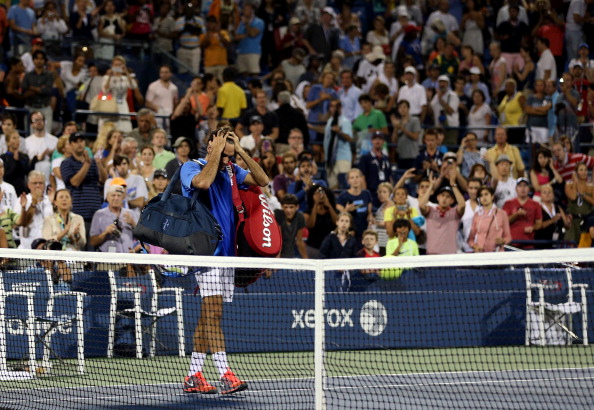
By Bill Simons
In 2008, New York journalist Lloyd Carol noted the obvious. “The aura of Roger Federer,” he said, “hangs all over the Open.”
But on the second Monday night of the US Open—this hot, muggy, unhappy New York night—all that hung were heads: confused, disbelieving ones. Gloom was pervasive, excellence had faltered. The King had stumbled. Our mighty champion looked ordinary, awkward, and less than noble.
Sitting courtside at Louis Armstrong, Gordon Smith, the Executive Director of the USTA, looked tense and solemn. Nearby in the bowels of Ashe stadium, the greatest Federer chronicler, the biographer Rene Stauffer, appeared grim. Up in the players’ box, Mirka Federer was gripped with tension. (“Stand by your man” has its challenges.)
In the stands, ten thousand fanatics were at a loss, almost dazed. Was this the same sublime Roger, the fast and fluid artist and power baller we have come to love: flowing free, feeling the ball, closing with certainty? Was this the dreamy master of the perplexing craft of tennis, the wizard fans had relished for a happy era?
No, emphatically no.
Our Roger—our hero, the mighty Federer—was in a funk.
For starters, upstart officials had exiled the King to a less-than-royal court, Louis Armstrong Stadium, where peasant and pauper and Anna Wintour alike roamed free. Here, where Federer hadn’t played since 2006, even Jersey Joe and Vinny from Brooklyn were quick to notice that Roger was, well, simply not Roger.
Then again, could it be that this is the new Roger: shockingly human, somehow vulnerable, hampered by doubt, less than explosive, far from confident, off-balance and free of ferocity? Where was the “I will not lose” fire?
Inexplicably, before us the King stood naked. “Where’s this guy’s swagger?” asked one writer. In the wake-like aftermath of Federer’s shock 7-6, 6-3, 6-4 loss to journeyman Tommy Robredo, who he had plastered ten straight times, a reporter told Roger, “You’re known as such a great closer, yet you were just 2-for-16 on breakpoints.”
“Yeah, that was a great close,” quipped the slightly peeved Federer. “No, it wasn’t a very good close today … We have a forehand here, end up losing the point like three times … it just ended up being a bad combination of many things today.”
And what a combination ’twas. After the match, Roger adeptly pointed to almost as many explanations for his loss as he had winners in the 2:24 encounter. He admitted he started slowly. (It seemed he was down 0-2 before the teen groupies from Great Neck could squeal ‘n scream, “C’mon Roger, you can do it!”) He admitted he “struggled throughout.” During the match, commentator John McEnroe said, “You know this guy is going to make a run.” But he never did.
Roger noted his “rhythm was off.”
No kidding.
Our game’s greatest strokemeister netted simple rally forehands and approach shots. Many of his backhands flew long. He suffered shanks and semi-shanks and he almost completely whiffed on a return of serve. Often he was outplayed in standard rallies.
With all due apologies to the songwriter: “Where have you gone, Roger Federer?”
Roger’s takes on his loss had a blunt, staccato regularity. He said he “was playing up and down,” that he beat himself and “self-destructed.”
But then again, what other player has been so able to conquer adversity? (Just ask Andy Roddick on his Texas couch.) In fact, after Federer dropped the first two sets against the 19th-seeded Spanish baseliner, Federerians were quick to point out that the Swiss had staged winning comebacks from two sets down eight times in his career.
After all, this was Roger, and as he observed later, “Confidence … takes care of all the things you don’t usually think about. But … it’s been a difficult three months … So I’ve definitely got to go back to work and come back stronger … [and] get rid of this loss now as quick as I can … I want to play better. I know I can. I showed it the last few weeks, that there is that level. So today was pretty frustrating.”
Indeed, fans, promoters, and media were left in a funk. Amazingly, Nadal and Federer had never played at the Open. They were destined for a quarterfinal dream match that now will only be played in our imagination. This was Roger’s earliest Open loss since ’02 and his first straight-set loss at the Open since ’03.
As bad a blow as this defeat was, it’s also consistent with Federer’s year. Yes, on occasion we’ve seen some laser forehands, that beautiful backhand, and nonchalant drop shot-and-lob combos that shouted brilliance. Plus, in Cincinnati, he played an inspired first set against Nadal. But his results have been—if we are allowed to say this—less than Federerian. He reached the semis of just one Slam (Australia), posted only one minor tournament win (Halle), and suffered upsets to wannabes with triple-digit rankings, all the while watching his ranking slide to No. 7. Worse yet, he gave us few hints that the bleeding will stop soon.
Instead, we are left to ponder the first headline we saw after Roger’s loss, and ask this plaintive question: Is it true that the Roger Federer we’ve known is gone?
Let’s hope not.


















